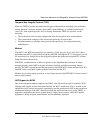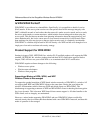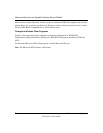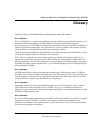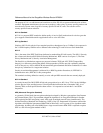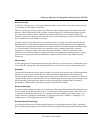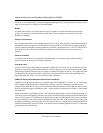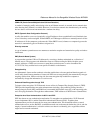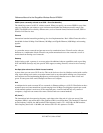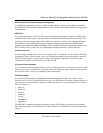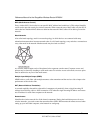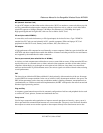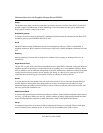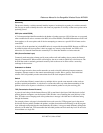
Reference Manual for the RangeMax Wireless Router WPN824
Glossary
5
202-10072-01, March 2005
CSMA/CD (Carrier Sense Multiple Action/Collision Detection)
A method of managing traffic and reducing noise on an Ethernet network. A network device transmits data
after detecting that a channel is available. However, if two devices transmit data simultaneously, the sending
devices detect a collision and retransmit after a random time delay.
DHCP (Dynamic Host Configuration Protocol)
A utility that enables a server to dynamically assign IP addresses from a predefined list and limit their time
of use so that they can be reassigned. Without DHCP, an IT Manager would have to manually enter in all the
IP addresses of all the computers on the network. When DHCP is used, whenever a computer logs onto the
network, it automatically gets an IP address assigned to it.
Diversity: antenna
A type of antenna system that uses two antennas to maximize reception and transmission quality and reduce
interference
DNS (Domain Name System)
A program that translates URLs to IP addresses by accessing a database maintained on a collection of
Internet servers. The program works behind the scenes to facilitate surfing the Web with alpha versus
numeric addresses. A DNS server converts a name like mywebsite.com to a series of numbers like
107.22.55.26. Every website has its own specific IP address on the Internet.
Encryption Key
An alphanumeric (letters and/or numbers) series that enables data to be encrypted and then decrypted so it
can be safely shared among members of a network. WEP uses an encryption key that automatically encrypts
outgoing wireless data. On the receiving side, the same encryption key enables the computer to
automatically decrypt the information so it can be read.
Enhanced Data Encryption through TKIP
To improve data encryption, Wi-Fi Protected Access utilizes its Temporal Key Integrity Protocol (TKIP).
TKIP provides important data encryption enhancements including a per-packet key mixing function, a
message integrity check (MIC) named Michael, an extended initialization vector (IV) with sequencing rules,
and a re-keying mechanism. Through these enhancements, TKIP addresses all WEP known vulnerabilities.
Enterprise-level User Authentication via 802.1x and EAP
WEP has almost no user authentication mechanism. To strengthen user authentication, Wi-Fi Protected
Access implements 802.1x and the Extensible Authentication Protocol (EAP). Together, these
implementations provide a framework for strong user authentication. This framework utilizes a central
authentication server, such as RADIUS, to authenticate each user on the network before they join it, and also
employs "mutual authentication" so that the wireless user doesn’t accidentally join a rogue network that
might steal its network credentials.



